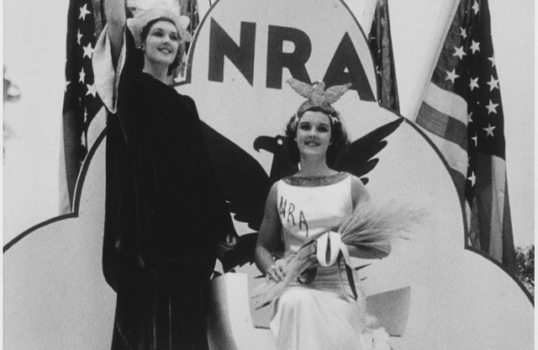What Is the New Deal with the New Deal?
Editors’ Note: It is quite striking how many similarities we have today with another thuggish Democrat, Franklin D. Roosevelt. The New Deal was the template for the modern welfare/warfare state and for the abuse of the electoral process, and the court system. Looking back, it seems fantastic that so many Americans were ready to give up their liberties during the 1930s. But that was during a major economic crisis, and later a world war. Before we judge those in the past, we have to acknowledge many Americans are willing to give up their liberties today with a far lower threshold. In both cases, crises, both manufactured and natural, are the stimulant for tyranny.
David Beito’s The New Deal’s War on the Bill of Rights: The Untold Story of FDR’s Concentration Camps, Censorship, and Mass Surveillance (Oakland: Independent Institute, 2023) is one of at least four recently published and forthcoming books to pummel the four-term administration of Franklin D. Roosevelt (FDR), especially its so-called New Deal policy platform.
It’s about time, as the ninetieth anniversary of FDR’s first term and the (in)famous First Hundred Days passed earlier this year with the banners of FDR hagiographers and New Deal acolytes still firmly in possession of the historiographical battlefield. Beito, though, has helped to expose a flank that a brigade of New New Deal historians could exploit.
The title of Beito’s book neatly encapsulates its thesis but hopefully without frightening away readers. It’s an eye-popping narrative political/policy history, not a comprehensive constitutional legal tome. It avoids the New Deal’s assault on the Second Amendment, for example, and arcane discussions of court decisions and constitutional doctrines are (most would say thankfully) also absent.
After a short, smart introduction, Beito in the first chapter describes the mass surveillance undertaken by then US Senator, erstwhile Ku Klux Klanner, and future Supreme Court Justice Hugo Lafayette Black. Among other civil rights atrocities, Black’s committee cajoled access to and read millions of private telegrams, the early twentieth century equivalent of social media DMs. Beito notes that the precedents set by Black were much worse than those of maverick Joseph McCarthy, the postwar communist witch hunter because Black enjoyed the full backing of the executive branch.
Black’s mass surveillance regime somehow did not make it into any of my high school or college history textbooks, and chances are it’s new information to you, too. The rest of Beito’s book reveals yet more largely forgotten and successfully suppressed instances of FDR’s destruction of democratic norms.
Chapters two and three cover the censorship shenanigans of another future Supreme Court Justice and U.S. Senator with an executive branch-sanctioned committee, Sherman Minton. From his bully pulpit on Capitol Hill, and with ample aid from Treasury tax officials, Minton sought to force anti-New Deal newspaper publishers, like Moses Annenberg of the Philadelphia Inquirer into complying with the administration’s approved narrative.
Unable to control all the nation’s many newspapermen with such strongarm tactics, Minton tried to pass a law imposing a stiff fine and jail time for anyone who knowingly published false information. Many civil libertarians on both sides of the aisle thankfully joined forces to squelch the bill, which they rightly saw as a harbinger of totalitarianism.
Chapters four and five describe how FDR came to dominate the airwaves, not just with his famous Fireside Chats and other radio addresses but by using federal control of the broadcast spectrum to literally silence his critics, which grew legion as employment and output levels remained far below those of 1929 despite his administration’s ample economic and social engineering experiments. Herbert Hoover paved the way for FDR’s takeover during his stint as Commerce Secretary by deliberately encouraging a wavelength crisis that resulted in increased federal oversight of the nascent industry in the 1927 Radio Act. Almost the entire radio industry remained at FDR’s beck and call from 1933 until his death in 1945.
The remaining chapters cover blatant and substantial election interference in Memphis, Tennessee in 1940 (6), FDR’s large and deeply eugenicist and racist role in the internment of 120,000 Japanese-Americans (7), too-often-downplayed wartime speech restrictions that sought to prove that America was not a “pudgy democracy” even if that meant reducing the Constitution to a “scrap of paper” (8), and a forgotten sedition trial that ended in fiasco for the prosecution, which overstepped both its evidence and the bounds of rationality in its zeal to convict a couple dozen newspapermen of promoting American fascism (9).
The book’s substantive conclusion, which details the ways in which the Truman administration continued the New Deal’s lamentable record on the Bill of Rights and opened the door to McCarthy’s anti-Communist crusade, also paints FDR’s civil rights record in a light that is highly negative. Beito’s book, though, remains clearly nonpartisan because it always “brings the receipts,” often in triplicate (archival, printed primary, and secondary sources).
Specifically, Beito draws on classic critiques of the New Deal, like those sampled by Amity Shlaes in New Deal Rebels, as well as some of the books critical of the New Deal that began to appear around the turn of the century, including Shlaes’s The Forgotten Man and Burton Folsom’s New Deal or Raw Deal?. It also draws on the better standard secondary sources and some too-often-overlooked doctoral dissertations. It also references standard archival sources, like the papers of FDR and his wife, and lesser-known sources like the papers of John T. Flynn, Amos Pinchot, and Edward E. Rumely.
Given its dense documentation, little about the book could be criticized directly, so look for progressive liberals to ignore it, as they tend to do with all well-written and -well-researched books that threaten statist status quo narratives. The book does what it does, expose the unseemly illiberal underbelly of the New Deal behemoth, effectively and efficiently.
What the book does not do, even in passing, is to make clear that the New Deal was completely unnecessary economically. The Federal Reserve’s bumbling and Hoover’s tariffs and high wage policies explain the first phase of the Depression, while FDR’s Blue Eagle, high taxes, business bashing, and high wage policies explain the stalled recovery. Reflation of the money supply and consistent business policies would have restored employment and output by 1934. Many contemporaries understood that, but due to government censorship and propaganda false economic narratives prevailed then and remain potent progressive talking points to this day.
Ultimately, financial journalist Garet Garrett was correct when he called the New Deal a sort of quiet revolution during which “the ultimate power of initiative did pass from the hands of private enterprise to government.” Resistance proved largely futile then and the New Deal’s ill effects have compounded over time. With help from books like The New Deal’s War on the Bill of Rights, however, the tide of historiographical battle may finally turn, and with it many old canards about the culpability of the gold standard, stock shorting, greed, and so forth in the downturn. Government policies, including attacks on freedom of expression and due process, lengthened and deepened a regular business cycle ebb into the Great Depression and set a long string of dominoes tumbling down, leaving frighteningly few erect today.
*****
This article was published by AIER, American Institute for Economic Research, and is reproduced with permission.




